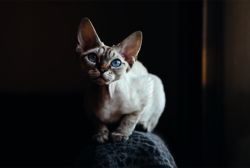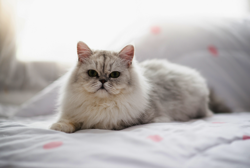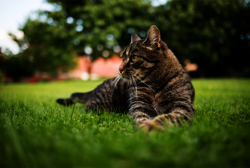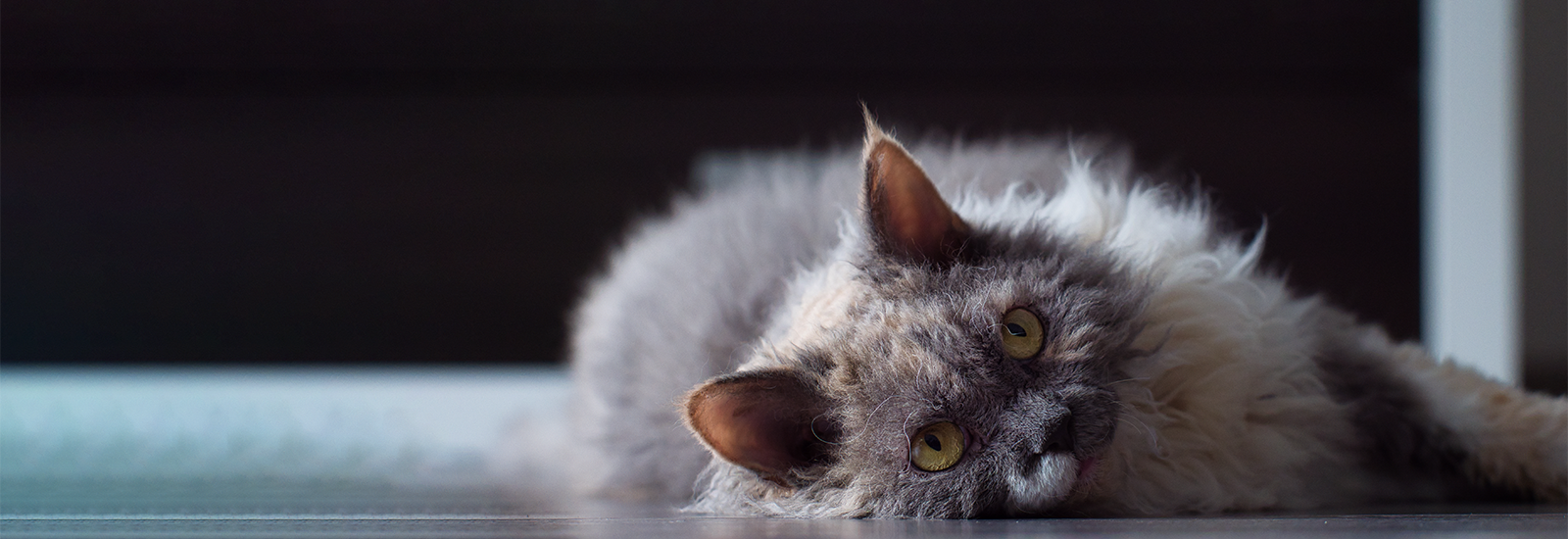Selkirk Rex
The Selkirk Rex is a curly-haired cat with a luxurious coat. Like all Rex cats, it is the result of a random mutation. Thanks to the subsequent pure breeding, a very affectionate, playful breed of cat has emerged that loves to be cuddled.
Profile of the Selkirk Rex
- Size medium
- Weight female: approx. 5 kg, male: approx. 6 kg
- Origin USA
- Build strong, rectangular body
- Length of fur curly, short or medium-long
- Colour of fur all colours
- Grooming easy
- Behaviour playful, affectionate
- Character self-confident, inquisitive
Appearance and character of the Selkirk Rex cat
The Selkirk Rex is one of the so-called “curly cats”. There are a number of distinct differences between the cats in this category: some of them only have fine, soft fur, while others have a very luxuriant coat. One of these is the Selkirk Rex, which originates from the USA. It is not surprising that they have such magnificent fur; after all, their ancestors include Persian cats. There are, however, two types of coat: as well as medium-length fur, you will occasionally find short-haired kittens in a litter. Both types have a very soft, fluffy, dense coat. The breed standard does not allow any bald patches or areas of sparse hair on the body. In addition, the coat should not lie flat, but should stand out from the body. It is also desirable for the curls to be random, unstructured and arranged in loose, individual curls. This gives the Selkirk Rex a casual, relaxed appearance.
The Selkirk Rex is descended from a domestic short-haired cat and has been crossed with various other breeds over time. As a result, the choice of colours is almost unlimited. From white to black, single or multi-coloured, with or without points, everything is allowed. There are also no restrictions on the colour of the eyes. There are, however, some requirements regarding the overall build: it should be medium to large in size and well-proportioned. The body should be strong, the head rounded and the nose fairly short. Curly whiskers are also desirable.
The Selkirk Rex is a very friendly, affectionate breed of cat that loves to be cuddled. It does not want to be the centre of attention, but at the same time it does not like being overlooked or ignored. It is highly adaptable, very self-confident, resistant to stress and open to just about anything. A Selkirk Rex likes playing and other activities with its humans, as well as long cuddling sessions. If it is not getting enough of these, it will follow you around, nudge you, and use its gentle little voice to let you know that it is time to spend some quality time together.
Keeping and caring for a Selkirk Rex
The Selkirk Rex is an affectionate breed of cat that does not like to be left at home alone. Breeders are especially aware of this, which is why some are not prepared to sell their cats individually. They only sell them in pairs or if they know that there is already a cat in their future home. The Selkirk Rex is not only very good with other cats, but also with its human two-legged friends. It is usually kept as a strictly indoor cat, which is why it so often seeks contact with us. It is inquisitive, keeps following after its owners, and will constantly walk around your legs if it is hungry or wants to be stroked. This is an absolute delight with the fluffy Selkirk Rex, which is why you should never miss out on a wonderful cuddling session with your pet.
If you want to adopt a Selkirk Rex as a family cat, this should be relatively problem-free, because it can easily cope with a little hustle and bustle. If things get too much for your pet, there should be enough places for it to retreat to in your home. A high cat tree and cuddly caves are, for example, ideal. It does not need to be let out if it receives enough affection and has plenty of things to keep it occupied indoors.
Unlike most other Rex cats, the Selkirk Rex has a very dense, luxuriant coat. Grooming will therefore be a little more time-consuming. You should gently run a comb through its fur around twice a week to avoid matting. With a short-haired Selkirk Rex, just once a week is sufficient. The occasional bath is not normally necessary.
Nutrition
Whether it’s a kitten, an adult cat or a senior – the food for a Selkirk Rex cat should always be of high quality and tailored to its age. Cats are carnivores by nature, so cat food should always contain a high proportion of meaty ingredients. Sugar, flavour enhancers and artificial colourings and preservatives do not belong in the food.
animonda has the ideal food for every stage of your cat’s life. You can choose between kitten, adult and senior cat food. The products are specially formulated to meet the specific nutritional requirements of the different life stages of cats. This provides the best foundation for your pet to enjoy a long and healthy life.
Selkirk Rex: health
Rex cats sometimes suffer from hair loss. Cross-breeding with Persian cats and other breeds has, however, led to this only occurring very rarely in the Selkirk Rex. There are also no other hereditary diseases that are particularly common in this breed of cat. A test for polycystic kidney disease (PKD), especially common in Persian cats, is advisable. Affected cats should no longer be used for breeding. Particular care should also be taken when pairing, to ensure that fresh bloodlines are regularly introduced in order to minimise the risk of inbreeding and its harmful consequences.
If the Selkirk Rex is allowed to go outside, its fur should be regularly checked for parasites, which can easily hide in its curly coat.
History and breeding
As with all cats with curly fur, the Selkirk Rex is the result of a random coat mutation. In 1987, a domestic short-haired cat with six kittens was handed in to an animal shelter in Montana, USA. One of them had crinkly whiskers and curly fur. An employee brought this kitten to her friend, Jeri Newman. Although she was a breeder of Persian cats, she was nevertheless interested in this little ball of fur. When “Miss DePesto” was one and a half years old, she decided to mate her with one of her male Persian cats. Three of the offspring displayed the desired result, namely curly hair. Therefore, Jeri Newman waited for a further year until one of the offspring, with the name Oskar Kowalski, was old enough to be back-bred with his mother. This litter was also a success and three of the four kittens had curly fur. This marked the real start of pure breeding.
Now, all it needed was a name. Some initial ideas were along the lines of “American Rex”. However, the cat breeder decided against it and decided on the name Selkirk. This was her stepfather’s first name. It took a few more years for the breed to be officially recognised. In the meantime, not only Persian cats but also Exotic Shorthairs and British Shorthairs were crossed in. This was certainly no mistake from the point of view of healthy breeding. In 1994, the International Cat Association and the Cat Fanciers’ Association finally gave the Selkirk Rex official recognition. It took until 2017 for the European governing body FIFe to follow suit.
You may also like this

Cornish Rex
The curly cat evolved from a domestic cat

Devon Rex
Their thin and curly hair make the breed particularly

Persian cat
A calm and affectionate cat breed with a very long coat

European Shorthair
Our domestic cats also have a lot to offer

